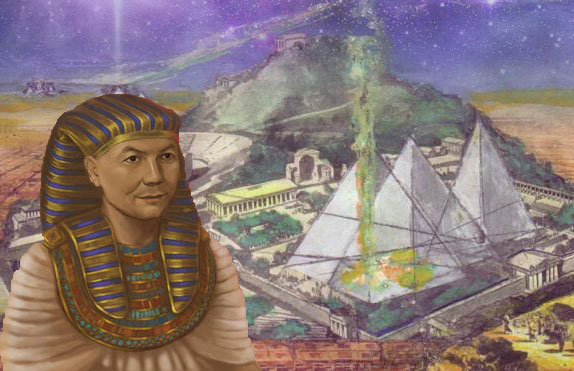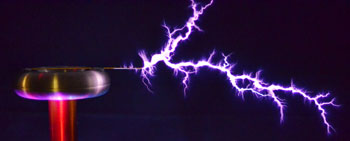Atlantean Civilization Part I
 Amid The Pyramids
Amid The Pyramids
Excerpt from Tempus Interludium I
Part One
October 7, 1969 — “During the last hundred years or so, peoples of the western hemisphere have been tremendously interested and intrigued by the lore of Ancient Egypt, as it was unearthed and apparently translated by the efforts of archaeologists. By far, however, the most important aspects in this Egyptology have not been recognized and, in particular, the significance of certain connections which this Egyptology had, in a historical sense, with the much older and long-ago defunct civilization of Atlantis.
In particular, the Egyptian pyramids, a subject of great mystery and intense controversy, even to the exploration of the giant pyramid of Gizeh (Pyramid of Khufu or Cheops at Gizeh) with cosmic ray apparatus in an attempt to divulge certain supposed unknown inner chambers. Like almost all other  earth world ethnic cultures, religions, occultisms and even superstitions, the Egyptian pyramid is actually a vestigial remnant, a degenerate form done in stone, of what was once actually a great electronic instrument, designed and constructed by master scientists from another world and placed on an Atlantean plain for the purposes of generating unlimited power derived from the interdimensional cosmos.
earth world ethnic cultures, religions, occultisms and even superstitions, the Egyptian pyramid is actually a vestigial remnant, a degenerate form done in stone, of what was once actually a great electronic instrument, designed and constructed by master scientists from another world and placed on an Atlantean plain for the purposes of generating unlimited power derived from the interdimensional cosmos.
As it existed on the Atlantean Plain some 15,000 B.C., it was constructed of metals, not stone. The geometrical configuration of the pyramids was purposefully placed in relationship to north and south magnetic poles and with the four sides representing maximum surface interception. On the metallic surface of this pyramid were placed millions of small cells whose purpose was to absorb cosmic energies and convert them into electrical energy which could turn certain kinds of electrical motors coupled to huge generators.
Our present-day modern cameras utilize a small cell of selenium which absorbs light and transmits it into electrical energy which opens and loses the diaphragm aperture of the camera, a parallel to the cells of the pyramid which covered its entire four surfaces, and as the pyramid was possibly a thousand feet high covering ninety-six acres of ground, the total number of cells involved when hooked together could generate tremendous power. (The great pyramid Khufu, or Cheops, at Gizeh was 482 feet high covering 13 acres.)
 The story of Amon Ra who came to Atlantis about 15,000 B.C., arrived there in a spaceship, together with a number of scientists and technicians who proceeded to construct a pyramid on the Atlantean plain; a pyramid which was exactly similar to that constructed on the plains of Ancient Lemuria some 140,000 years before that time. The story of the construction of this pyramid was later, through succeeding generations of earth people and handed down as they were, degenerated into legends not entirely accurate and with considerable elements of mysticism.
The story of Amon Ra who came to Atlantis about 15,000 B.C., arrived there in a spaceship, together with a number of scientists and technicians who proceeded to construct a pyramid on the Atlantean plain; a pyramid which was exactly similar to that constructed on the plains of Ancient Lemuria some 140,000 years before that time. The story of the construction of this pyramid was later, through succeeding generations of earth people and handed down as they were, degenerated into legends not entirely accurate and with considerable elements of mysticism.
The typical ‘Tower of Babel’ story in the Old Testament was derived from this legend, i.e., the ancient tribes-people believed the Lemurians were building a tower to heaven, etc.
Then it was Amon Ra and his technicians had constructed the Atlantean pyramid, the interior of which was devoted to different sections, rooms, etc., all integrated in the development and distribution of this enormous power which was generated in these generators in the subterranean vault beneath the floor.
 In the center of the pyramid and on the floor stood the switchboard — not like the switchboards in power-houses today but rather, it was a metal box about 20 feet square which contained a robot or computer which, in its function in the conversion and distribution of this energy and the enormous power involved, generated an electromagnetic field around it of such intensity that the metal appeared to glow much like an overheated stove turns red.
In the center of the pyramid and on the floor stood the switchboard — not like the switchboards in power-houses today but rather, it was a metal box about 20 feet square which contained a robot or computer which, in its function in the conversion and distribution of this energy and the enormous power involved, generated an electromagnetic field around it of such intensity that the metal appeared to glow much like an overheated stove turns red.
This glow gave the appearance that the box was actually pure crystalline energy. This box also performed another important function.
From the top of the box was a round metallic sphere about 10 feet in diameter and from this ball, which was actually a positive pole, a flame-like protuberance of energy stood straight up toward the apex of the pyramid where, from a long rod, there hung another similar sphere of metal.
The purpose for which this ‘flame’ of energy existed was one of extreme technical importance,  inasmuch as the net total oscillations of energy generated in the cells on the outside surface of the pyramid were, in this process with the `flame’, converted into usable high-frequency energies which were beamed into the nearby homes and other buildings of the Atlantean cities of Atlantis, eliminating the need for wires, transformers, poles, etc., with which we are familiar in our present-day towns and cities. Our modern radar ranges use this method of shortwave energy radiations to cook food.
inasmuch as the net total oscillations of energy generated in the cells on the outside surface of the pyramid were, in this process with the `flame’, converted into usable high-frequency energies which were beamed into the nearby homes and other buildings of the Atlantean cities of Atlantis, eliminating the need for wires, transformers, poles, etc., with which we are familiar in our present-day towns and cities. Our modern radar ranges use this method of shortwave energy radiations to cook food.
Now it is easily understandable that in these ancient times, either Lemuria or Atlantis, when the ignorant, superstitious aboriginal natives of this planet saw or heard about this wonderful scientific technocracy, they could not understand it and it became a great mystery to them. The square box in the middle of the floor became a pure cube of energy; the flame, which stemmed from the top upward toward the overhanging metallic ball appeared motionless but was actually pulsating or oscillating thousands or billions of times per second, at speeds too incomprehensible to see or even understand by our present-day mathematics.
In the early part of this century, Nikola Tesla developed his famous Tesla Coil, the top of which, from a round spherical ball, great lightning-like streamers of energy many feet long extended to nearby  objects. Was Tesla, through a psychic memory, attempting to reproduce the great technical wonder which he saw in the great Atlantean temple? And many thousands of years before, when the Ancient Egyptians built the pyramid of Gizeh, they covered the outside surface with a monolithic alabaster-like material of an unknown composition in an attempt to duplicate the white metallic surface of the Atlantean pyramid.
objects. Was Tesla, through a psychic memory, attempting to reproduce the great technical wonder which he saw in the great Atlantean temple? And many thousands of years before, when the Ancient Egyptians built the pyramid of Gizeh, they covered the outside surface with a monolithic alabaster-like material of an unknown composition in an attempt to duplicate the white metallic surface of the Atlantean pyramid.
Yet, the Egyptians, descendants of the aborigines who had survived the cataclysms, only vaguely, psychically remembered; supported, no doubt from legends of the old Atlantean temple which they tried to duplicate, yet, with none of the science or technocracy and knowing little or nothing of electronics, they could only build their pyramid from stone blocks and cover it with a white alabaster.
Perhaps the science brought to Lemuria and Atlantis by the Lemurians will, in the near future, be duplicated on this earth. Already different countries through out the world are building great power plants, deriving great power from the atom. Yet, this is very crude when compared to the science of  the Atlantean pyramid which converted from the electromagnetic fields of the solar system and the interdimensional cosmos, a vast Source of Power which could be projected by ray-beams and reflected from tower to tower (like our present-day microwave system), tremendous energy which powered and lighted cities all over the world.
the Atlantean pyramid which converted from the electromagnetic fields of the solar system and the interdimensional cosmos, a vast Source of Power which could be projected by ray-beams and reflected from tower to tower (like our present-day microwave system), tremendous energy which powered and lighted cities all over the world.
The future holds the promise that all of this and much more will return to the earth. The people of tomorrow will have undreamed of luxuries and conveniences, a way of life which will exceed even the most fantastic science fiction stories; yet will our present day mankind be able to survive? Indeed not. The homogeneous mixture of races presents a far too low state of mentality, a heterogeneous society torn and twisted with strictures and rent by irreparable schisms.
And it is quite safe to predict in that future, should it ever arrive, the breed of man who will occupy it will be vastly different than those presently now living — a comparison to the golden-skinned Atlanteans in their beautiful highly-scientific society which, through its egregious philosophy, permitted the dark-skinned ones to overpower and destroy the world. And is it not apparent that in this time history is beginning to repeat itself?
Historically speaking, anthropology has always very severely abrogated the way of life in the ancient civilizations  which it has uncovered. There have been no apparent evidences of any other kind of a society or ecology which would suggest a certain scientific aspect of life lived by the Ancients. In some instances, however, this could be far from the truth. Scientific or electronic apparatus, as it might have been used in any ancient civilization would be most necessarily, comparatively fragile, the apparatus small in size and portable, and could have long ago disappeared, at least partly into pots, pans, jewelry or temple bells and such things.
which it has uncovered. There have been no apparent evidences of any other kind of a society or ecology which would suggest a certain scientific aspect of life lived by the Ancients. In some instances, however, this could be far from the truth. Scientific or electronic apparatus, as it might have been used in any ancient civilization would be most necessarily, comparatively fragile, the apparatus small in size and portable, and could have long ago disappeared, at least partly into pots, pans, jewelry or temple bells and such things.
For example: One archaeological report cites the uncovering of electrolytic batteries in an ancient pre-Babylonian city more than 4,000 B.C. Artisans at that time were electroplating jewelry with gold, just as it is done at the present time. The batteries actually generated electricity when the electrolyte was refreshed.
Also about 4,000 B.C., according to archeology, the ancient Minoan civilization thrived somewhere in the Mediterranean just off the Grecian peninsula. The Minoans are said to have be en highly cultured; they wrought beautiful ceramics, pottery, jewelry and other artifacts, delicately engraved and colored; the interiors of their homes, the floors and walls of which exhibited beautiful murals. Descriptions of their houses said they were air-conditioned but from totally opened doors and windows, apparently without any means of covering or closing. Now this is quite preposterous; even a primitive savage living in a grass thatched hut can cover the door with a wild animal skin.
en highly cultured; they wrought beautiful ceramics, pottery, jewelry and other artifacts, delicately engraved and colored; the interiors of their homes, the floors and walls of which exhibited beautiful murals. Descriptions of their houses said they were air-conditioned but from totally opened doors and windows, apparently without any means of covering or closing. Now this is quite preposterous; even a primitive savage living in a grass thatched hut can cover the door with a wild animal skin.
The climate in the Mediterranean areas can become quite cold in winter; snow falls in Italy and Greece, and summers are unbearably hot. Although the Minoan houses were apparently all constructed of carved stone blocks and beamed ceilings, ways and means would certainly have been used to close door and window openings.
Doors and door frames, and window glass and window frames could have long ago vanished in the hands of vandals or to people who wished to use wood for their own purposes. Glass, stained or otherwise, would also have been useful. Interiors of the houses could have been heated with large metal urns or braziers which burn palm or whale oil. And there is a possibility that this Minoan civilization or even more ancient civilizations could have enjoyed electrical and mechanical technocracy far in advance of our present time.
From the great central pyramid in Atlantis, power beams would be relayed from reflectors on mountaintops into the different homes where these power beams would be converted into light, heat or even to cool the house. The proposition here is relatively simple. A round glass globe or sphere about a foot in diameter and filled with certain rare gases would fluoresce and give off a soft white light, just as does our modern fluorescent light. Heating or cooling is also simple: Air is made up of molecules of gases, each molecule composed of a number of atoms. Electrical energy of a certain frequency when radiated through air is converted into heat through hysteresis in the electromagnetic fields of the atoms.
 The same proposition in reverse makes the air become cold, remembering of course, that all atmosphere on the earth is always converting this certain electromagnetic energy into heat. Speaking from the point of absolute zero — -495 degrees Fahrenheit — all air on the surface of the earth is comparatively warm, even at the poles. Cooling or heating the air at any given point means merely to decrease or increase the electromagnetic hysteresis.
The same proposition in reverse makes the air become cold, remembering of course, that all atmosphere on the earth is always converting this certain electromagnetic energy into heat. Speaking from the point of absolute zero — -495 degrees Fahrenheit — all air on the surface of the earth is comparatively warm, even at the poles. Cooling or heating the air at any given point means merely to decrease or increase the electromagnetic hysteresis.
In a Minoan house, for example, a small object a foot or so square sitting on the floor of any room could be both the heater and the cooler. It would, according to the dictates of a thermostat, radiate certain energies into the room which would either slow down hysteresis and make the air cooler or speed up hysteresis and make the air warmer; a far different process than our present-day crude, clumsy, inefficient and enormous heating and cooling systems which must always either heat air in a furnace or cool it by means of refrigeration and, with a fan, blow it into the room through a large duct.
Again, any of these small air-conditioning units would have most certainly disappeared many thousands of years ago. Superstitious people may have destroyed them thinking they were evil or converted them into jewelry or weapons or destroyed them in other ways. Only the stone skeletons of the houses remain which bear only a small fragment of testimony as to a great and wonderful way of life lived in one of these ancient cities of the Atlantean epoch.
(Amon Ra: The literal translation of Amon Ra means sun-god. The superstitious natives, when they saw the glowing white spaceship, thought that the sun-god had come to earth, hence the name Amon Ra.)
The technical description of the generator-oscillator banks and the generation of the `flame’, while very complex, can be more easily understood with this simplified explanation: In the subterranean chamber beneath the floor stood the motor-generator combination mounted on a vertical shaft . This piece of machinery worked exactly similar to our present day Pabst synchronous-hysteresis motor, that is, exactly in reverse to ordinary motors which have a rotor rotating inside fixed stationary field coils.
. This piece of machinery worked exactly similar to our present day Pabst synchronous-hysteresis motor, that is, exactly in reverse to ordinary motors which have a rotor rotating inside fixed stationary field coils.
In the Pabst motor, the rotor is stationary and the metal field terminals rotate around it, similar to a squirrel cage. The Atlantean motor-generator combination works as follows: a huge externally-powered, (A.C.) alternating current motor rotated the squirrel cage which was actually a large number of extremely powerful high-gauss, high-intensity magnets affixed to the metal frame which rotated around what would normally be the rotor which was made from a high-permeability, soft iron core. Wound around a large number of these poles were almost countless thousands of turns of insulated wire.
These coils were, in turn, connected up to different banks of cells on the outside skin surface of the pyramid. The sequence of this wiring was such, that when the magnets turned around the rotor, the cells and the magnetic currents so generated were in extremely rapid sequence which built up an extremely high-frequency oscillating voltage which discharged across the two balls which I described previously. The purpose of this gap was to stabilize these oscillations under resistive conditions in open air.
 As every electrophysicist knows certain fundamental law of electronics — increasing the frequency increases the voltage or power — that is why a laser beam can pierce a diamond with less energy than would light a small flashlight. The energy from a five-foot long lightning bolt from a Tesla coil (500,000 Cycles per second) is less than two millionths of an ampere and would cause only a mild tingling sensation. A lightning bolt traveling from a cloud to the earth contains only enough energy to light a hundred-watt bulb for about thirty seconds.
As every electrophysicist knows certain fundamental law of electronics — increasing the frequency increases the voltage or power — that is why a laser beam can pierce a diamond with less energy than would light a small flashlight. The energy from a five-foot long lightning bolt from a Tesla coil (500,000 Cycles per second) is less than two millionths of an ampere and would cause only a mild tingling sensation. A lightning bolt traveling from a cloud to the earth contains only enough energy to light a hundred-watt bulb for about thirty seconds.
Electronic scientists of today however, are still a bit mixed up on the proposition of voltage versus frequency. They string 1/2 inch thick laminated cable across the countryside for hundreds of miles from tall steel towers and push electricity through these cables in far-away cities at voltages in excess of 300,000 and at only 60 cycles per second alternating frequency, whereas a small pencil-thin power beam oscillating at hundreds of millions of times per second could be reflected from tower to tower across country; one beam carrying sufficient power to energize the largest city.
In 1899, out in Colorado, Tesla sent electrical beams through the earth and lighted up light bulbs five miles away.
miles away.
Flying saucers or spaceships are energized and fly by exactly the same principle as used in the Atlantean oscillator-generator or the Pabst hysteresis-synchronous motor. Perhaps when certain pseudo elements of our scientific society stop denying the ever-apparent infinite cosmos and the countless billions of different types of civilizations living on countless billions of planets, they will begin to at least admit the possibility that space travel across the galaxy or the universe is not only feasible but has been going on for millions of years.
Enigmatically, many of these moss-backed, hard-nosed pseudo-scientists have, in some way, been advocating or participating in our present-day space effort. We have already accomplished the moon and Mars is the next tentative target in the 1990’s.”
Posted in Book Excerpts, Tempus Interludium, True History of Manwith comments disabled.





